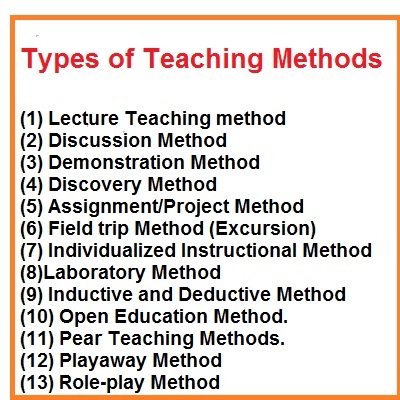Meaning of Methods Teaching
Methods of teaching refer to the specific instructional process adopted or utilized in delivering learning material for effective learning achievement in the classroom.
Similarly, it refers to a set of instructional techniques used in imparting knowledge in teaching-learning processes.
The success of teaching and learning depends on the types of teaching methods adopted. The methods utilized in passing knowledge to the students differ from one method to another as well as the learning materials under study.
The methods also differ according to the level of students and the categories of students to be taught. The methods adopted for teaching primary school differ from that of the school secondary school.
The teaching methods adopted for teaching vocational and technical education science differ from that of political science. No two teaching methods are the same, they have their own unique features procedure, and steps.
However, irrespective of the variability of the teaching method adopted they can be manipulated at varying degrees to achieve the target objective. The types of Teaching methods adopted in the teaching and learning process influence the nature of knowledge imparted, the extent of assimilation of learning outcome, and the accelerated material to be learned.
Some of these methods are teacher-centered while others student-centered. The teacher must choose or select the right teaching methods to achieve the predetermined objectives. The acquisition of these skills, attitudes, and knowledge, is done through a procedure. These procedures are called teaching methods.
The acquisition of skills in Technical and Vocational Education and Training (TVET) occurs in many forms, which could be formal, informal, and non-formal settings.
Wherever the (TVET) is taking place either in schools, public, or private organizations, skills acquisition centers, government-approved vocational education centers, vocational training centers, and so on, one form of teaching method or the other is been used.
The teacher of the TVET needs to be familiar with the methods that are needed for teaching at a particular time as well as the abilities of the TVET teacher to know the skills or procedures required for the utilization of a particular teaching method.
Type of Teaching of Methods
Some of the methods of teaching in Technical and Vocational Education and Training (TVET) as highlighted by the National Open University of Nigeria are:
- Lecture teaching method
- Discussion method
- Demonstration method
- Discovery method
- Assignment/project method
- Field trip method (Excursion)
- Individualized instructional method
- Laboratory method
- Inductive and deductive method
- Open education method.
- Pear teaching methods.
- Playaway methods
- Role-play method
The Lecture Teaching method
Lecture teaching methods are also called chalk-and-talk or Marker-and-talk methods. It refers to the method of teaching where the teacher uses only verbal expression to impart knowledge and skills to the learner throughout the lesson period.
It is the earlier form of methods of teaching used in transmitting knowledge in Teaching in Technical and Vocational Education and Training (TVET).
The lecture teaching method is teacher-centered because it is a teacher-dominated method. In this method of teaching the teacher reads from the handout, or lesson note, and explains by himself, with no or minimal uses of instructional materials.
In a lecture method, the teacher expresses ideas, concepts, and facts while the students remain passive, listening and only taking notes without playing an active role.
These methods of teaching involve one-sided means of communication as the information does not flow in two ways. This type of method of teaching is not appropriate for the teaching of people with low intellectual capacity or reasoning in Technical and Vocational Education and Training (TVET).
Although the methods are good for a large number of students and can be used to cover course outlines and lesson notes within a short time.
The lecture methods of teaching can be improved by the use of questioning methods, demonstration, and assignment methods for their effectiveness in teaching Technical and Vocational Education and Training (TVET).
This method can also be used in Technical and Vocational Education and Training (TVET) classes where there is no or little apparatus for demonstration or experiment.
Merit / Advantages of the Lecture Method
The advantages of this teaching method in Technical and Vocational Education and Training (TVET) are:
- The method is less expensive compared to the experimental method of teaching
- The method is less time-consuming on the part of the teacher
- The method is labour-effective as less effort is needed for planning and preparing for teaching.
- The method is very efficient when the teacher has a large work to cover in a short time
- The methods allow the teacher to handle a large population of students
- The methods help the student to develop critical thinking and listening skill
Demerits / Disadvantages of the Lecture Method
The demerit of the lecture teaching methods in Technical and Vocational Education and Training (TVET) are as follows
- The methods are not good for students with low intellectual capacity
- The method does not allow the students to be part of the lesson
- The methods may not allow the student to achieve the desired learning outcomes.
- Excess usage of the method will discourage students from coming to class as they will rely on the teacher’s notes only.
- Progress evaluation can’t be ascertained.
- The method is not holistic as it is meant for a higher level of learning.
